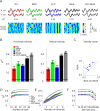Predicting movement from multiunit activity
- PMID: 17670985
- PMCID: PMC6673077
- DOI: 10.1523/JNEUROSCI.1321-07.2007
Predicting movement from multiunit activity
Abstract
Previous studies have shown that intracortical activity can be used to operate prosthetic devices such as an artificial limb. Previously used neuronal signals were either the activity of tens to hundreds of spiking neurons, which are difficult to record for long periods of time, or local field potentials, which are highly correlated with each other. Here, we show that by estimating multiunit activity (MUA), the superimposed activity of many neurons around a microelectrode, and using a small number of electrodes, an accurate prediction of the upcoming movement is obtained. Compared with single-unit spikes, single MUA recordings are obtained more easily and the recordings are more stable over time. Compared with local field potentials, pairs of MUA recordings are considerably less redundant. Compared with any other intracortical signal, single MUA recordings are more informative. MUA is informative even in the absence of spikes. By combining information from multielectrode recordings from the motor cortices of monkeys that performed either discrete prehension or continuous tracing movements, we demonstrate that predictions based on multichannel MUA are superior to those based on either spikes or local field potentials. These results demonstrate that considerable information is retained in the superimposed activity of multiple neurons, and therefore suggest that neurons within the same locality process similar information. They also illustrate that complex movements can be predicted using relatively simple signal processing without the detection of spikes and, thus, hold the potential to greatly expedite the development of motor-cortical prosthetic devices.
Figures






Similar articles
-
Decoding 3D reach and grasp from hybrid signals in motor and premotor cortices: spikes, multiunit activity, and local field potentials.J Neurophysiol. 2012 Mar;107(5):1337-55. doi: 10.1152/jn.00781.2011. Epub 2011 Dec 7. J Neurophysiol. 2012. PMID: 22157115 Free PMC article.
-
Accurate decoding of reaching movements from field potentials in the absence of spikes.J Neural Eng. 2012 Aug;9(4):046006. doi: 10.1088/1741-2560/9/4/046006. Epub 2012 Jun 25. J Neural Eng. 2012. PMID: 22733013 Free PMC article.
-
Local field potentials allow accurate decoding of muscle activity.J Neurophysiol. 2012 Jul;108(1):18-24. doi: 10.1152/jn.00832.2011. Epub 2012 Apr 11. J Neurophysiol. 2012. PMID: 22496527 Free PMC article.
-
A review on directional information in neural signals for brain-machine interfaces.J Physiol Paris. 2009 Sep-Dec;103(3-5):244-54. doi: 10.1016/j.jphysparis.2009.08.007. Epub 2009 Aug 7. J Physiol Paris. 2009. PMID: 19665554 Review.
-
Local field potentials for BCI control.Handb Clin Neurol. 2020;168:279-288. doi: 10.1016/B978-0-444-63934-9.00020-2. Handb Clin Neurol. 2020. PMID: 32164859 Review.
Cited by
-
Attentional capture? Synchronized feedback signals from the isthmi boost retinal signals to higher visual areas.J Neurosci. 2012 Jan 18;32(3):1110-22. doi: 10.1523/JNEUROSCI.4151-11.2012. J Neurosci. 2012. PMID: 22262908 Free PMC article.
-
Neural mechanisms of rhythmic masking release in monkey primary auditory cortex: implications for models of auditory scene analysis.J Neurophysiol. 2012 May;107(9):2366-82. doi: 10.1152/jn.01010.2011. Epub 2012 Feb 8. J Neurophysiol. 2012. PMID: 22323627 Free PMC article.
-
Multiunit Activity-Based Real-Time Limb-State Estimation from Dorsal Root Ganglion Recordings.Sci Rep. 2017 Mar 9;7:44197. doi: 10.1038/srep44197. Sci Rep. 2017. PMID: 28276474 Free PMC article.
-
Intra-day signal instabilities affect decoding performance in an intracortical neural interface system.J Neural Eng. 2013 Jun;10(3):036004. doi: 10.1088/1741-2560/10/3/036004. Epub 2013 Apr 10. J Neural Eng. 2013. PMID: 23574741 Free PMC article.
-
Reach and grasp by people with tetraplegia using a neurally controlled robotic arm.Nature. 2012 May 16;485(7398):372-5. doi: 10.1038/nature11076. Nature. 2012. PMID: 22596161 Free PMC article.
References
-
- Abeles M, Goldstein MH. Multispike train analysis. Proc IEEE. 1977;65:762–773.
-
- Andersen RA, Musallam S, Pesaran B. Selecting the signals for a brain-machine interface. Curr Opin Neurobiol. 2004;14:720–726. - PubMed
-
- Bauer R, Brosch M, Eckhorn R. Different rules of spatial summation from beyond the receptive field for spike rates and oscillation amplitudes in cat visual cortex. Brain Res. 1995;669:291–297. - PubMed
-
- Buchwald JS, Grover FS. Amplitudes of background fast activity characteristic of specific brain sites. J Neurophysiol. 1970;33:148–159. - PubMed
-
- Buchwald JS, Halas ES, Schramm S. Comparison of multiple-unit and electro-encephalogram activity recorded from the same brain sites during behavioral conditioning. Nature. 1965;205:1012–1014.
Publication types
MeSH terms
LinkOut - more resources
Full Text Sources
